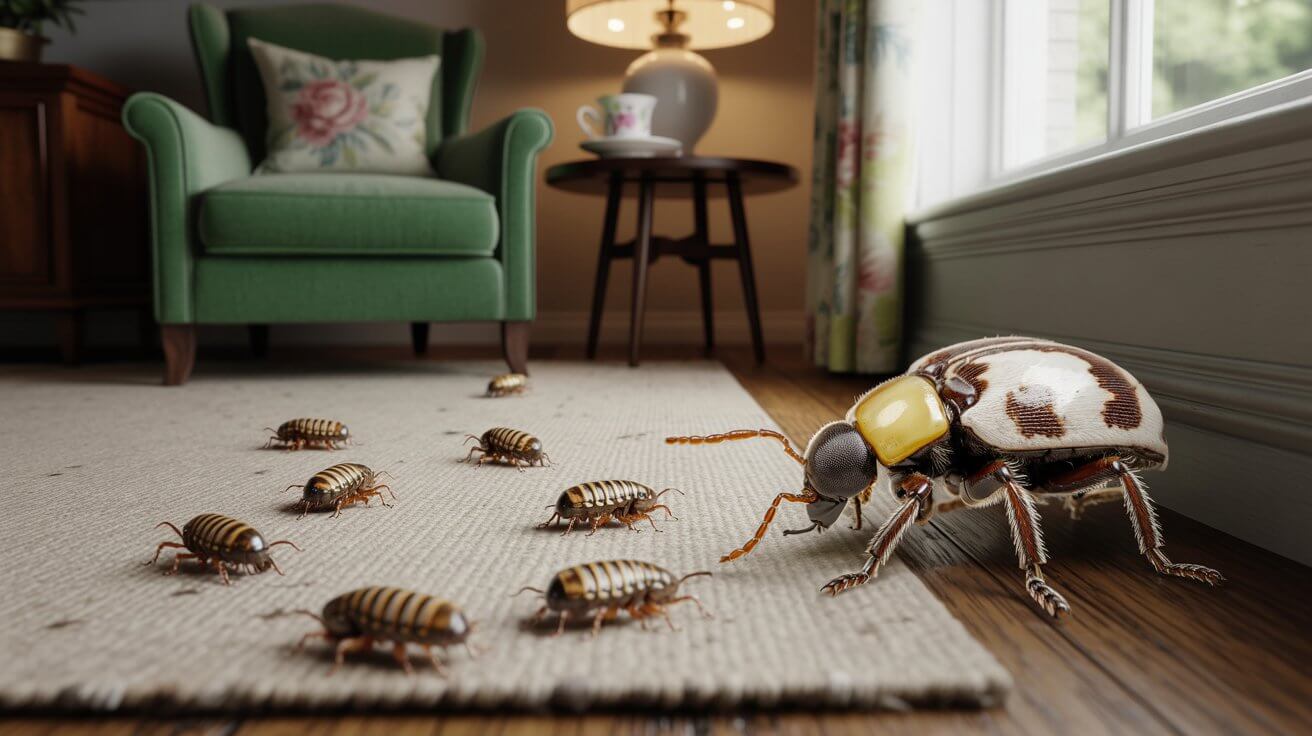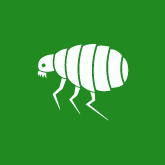Discovering unwanted visitors scurrying across your kitchen floor or finding mysterious holes in your favorite jumper can be alarming. UK homes face constant pressure from various pests seeking warmth, food, and shelter particularly during autumn and winter months when these creatures look for cozy indoor spaces.
Identifying household pests quickly is crucial for protecting both your property and your family’s health. Each pest species leaves distinct clues behind, from specific droppings patterns to unique damage signatures. Understanding these telltale signs helps you take swift action before a minor problem becomes a costly infestation.
This comprehensive guide explores the most common household pests found in UK homes, teaching you how to spot early warning signs and determine when professional intervention becomes necessary.
What Are the Most Common Household Pests in the UK?
British homes regularly encounter nine primary pest species: rats, mice, bed bugs, carpet beetles, cockroaches, wasps, clothes moths, fleas, silverfish, and woodworm. These pests thrive in different areas of your home and cause varying degrees of damage to property and health.
General Signs of a Pest Infestation
Several universal indicators suggest pest activity in your home. Look for unusual smells particularly musty, sweet, or ammonia-like odors that seem to originate from walls, cupboards, or hidden spaces. Strange noises during quiet hours, such as scratching, scurrying, or rustling sounds, often signal rodent activity.
Visual evidence includes droppings, shed skins, egg cases, or dead insects near windows, corners, and food storage areas. Property damage such as gnaw marks, holes in fabric, or crumbling wood also indicates pest presence.
Why Early Identification Matters
Swift pest identification prevents minor issues from escalating into expensive, widespread infestations. Many pests reproduce rapidly; a single pair of mice can produce up to 10 litters annually, with each litter containing 4-6 offspring.
Early detection also minimizes health risks associated with pest-borne diseases and reduces structural damage to your property. Insurance policies rarely cover pest-related damage, making prevention your most cost-effective strategy.
How to Identify Common Household Pests in the UK
Rats vs Mice Droppings, Gnaw Marks, Scratching Sounds
Distinguishing between rats and mice helps determine appropriate treatment methods. Mouse droppings measure 3-8mm long with pointed ends, appearing scattered near food sources. Rat droppings are larger (12-18mm) with blunt ends and typically cluster in specific areas.
Gnaw marks differ significantly between species. Mice leave small, clean bite marks around 1-2mm wide, while rats create rough-edged holes measuring 6-10mm across. Mice produce high-pitched scratching sounds in walls and ceilings, whereas rats create heavier, more deliberate movement noises.
Listen for activity patterns too. Mice remain active throughout the night, while rats typically forage during specific periods just after dusk and before dawn.
Bed Bugs Bites, Blood Spots, Mattress Stains
Bed bugs leave distinctive bite patterns, usually three bites in a row, earning the nickname “breakfast, lunch, and dinner” marks. These bites appear as raised, red welts that itch intensely and often occur on exposed skin areas like arms, shoulders, and neck.
Check your bedding for small blood spots or rust-colored stains, particularly near the head of your bed. Examine mattress seams, bed frames, and nearby furniture for dark spots (bed bug excrement), sweet musty odors, or small brown bugs about the size of an apple seed.
Look for shed skins and dark spots in mattress corners, behind headboards, and along carpet edges near beds.
Carpet Beetles Larvae, Shed Skins, Fabric Damage
Adult carpet beetles are small, oval insects measuring 2-4mm with mottled patterns of white, brown, and yellow scales. However, their larvae cause the most damage. These hairy, brown caterpillar-like creatures measure 4-7mm long and feast on natural fibers.
Fabric damage appears as irregular holes in wool carpets, clothing, and upholstery. Unlike moth damage, carpet beetle holes have smooth edges and often occur in clusters.
Find shed larval skins in dark, undisturbed areas like closets, under furniture, and along baseboards. Adult beetles are often spotted near windows during spring months when they’re attracted to light.
Cockroaches Droppings, Egg Cases, Foul Smell
Cockroach droppings resemble black pepper or coffee grounds, appearing in kitchen cupboards, behind appliances, and in warm, moist areas. Large roach species produce cylindrical droppings with ridge marks along the sides.
Search for brown, oval egg cases (oothecae) measuring 6-10mm long, often glued to surfaces in hidden locations like behind fridges or inside kitchen cabinets.
A distinctive musty, oily odor permeates areas with significant cockroach activity. This smell intensifies in enclosed spaces and becomes particularly noticeable in kitchens and bathrooms.
Wasps Visible Nests, Buzzing Activity Near Roofs
Wasp nests appear as grey, papery structures with hexagonal patterns, typically located in roof spaces, wall cavities, or garden sheds. These nests grow throughout summer, potentially reaching football size by autumn.
Increased wasp activity near your roof line, particularly around eaves and fascia boards, indicates nearby nesting sites. Wasps follow consistent flight paths to and from their nests, making observation easier during daylight hours.
Look for chewed wood particles around garden fences, sheds, or wooden furniture wasps collect wood fiber to build their nests.
Clothes Moths Irregular Holes in Fabrics, Moth Casings
Clothes moth larvae create irregular holes in natural fiber clothing, carpets, and furnishings. Unlike carpet beetles, moth damage typically shows frayed edges and often occurs in dark, seldom-used areas like wardrobe corners.
Adult moths measure 6-8mm with golden or buff-colored wings. They avoid bright lights, preferring dark spaces where they’re difficult to spot.
Find silken tubes or cases in affected clothing areas, along with small cream-colored larvae that measure up to 10mm long.
Fleas Itchy Bites, Black Flea Dirt in Carpets
Flea bites create small, red, intensely itchy spots, typically appearing around ankles and lower legs. Unlike other insect bites, flea bites often occur in clusters or lines.
“Flea dirt” (dried blood feces) appears as small black specks in carpets, pet bedding, and soft furnishings. Test suspected flea dirt by placing it on damp tissue it turns red-brown if genuine flea waste.
Watch for pets scratching excessively or developing red, irritated skin. Fleas jump when disturbed, making them visible on light-colored surfaces.
Woodworm Tiny Exit Holes in Wood, Crumbling Timber
Fresh woodworm activity produces small, round holes measuring 1-2mm diameter in wooden furniture, floorboards, or structural timbers. These holes have clean, sharp edges with light-colored wood dust nearby.
Tap suspected areas damaged wood sounds hollow and may crumble easily. Look for tunnel patterns beneath the wood surface, visible in severely affected pieces.
Check for adult beetles during summer months (May-August) when they emerge to mate. These brown beetles measure 2-5mm long and are attracted to lights.
Silverfish Small Metallic Insects, Holes in Paper/Books
Silverfish are wingless insects measuring 10-15mm long with metallic silver scales and three long tail appendages. They move in distinctive fish-like motions and prefer humid environments like bathrooms, kitchens, and basements.
Look for irregular holes in books, wallpaper, photographs, and cardboard boxes. Silverfish also leave small, pepper-like droppings and yellow stains on affected materials.
These nocturnal pests are most active during nighttime hours and quickly scurry away when lights turn on.
Pest Types Chart
| Pest Type | Key Signs | Health Risk | Damage Risk |
| Rats & Mice | Droppings, gnawing, noises | High (disease spread) | High (wires, food damage) |
| Bed Bugs | Bites, stains on bedding | Medium (bites, allergies) | Low (mainly discomfort) |
| Carpet Beetles | Fabric holes, larvae | Low | Medium (clothing, upholstery) |
| Cockroaches | Smell, droppings | High (contamination) | Medium |
| Woodworm | Tiny exit holes, weak wood | Low | High (furniture/structural) |
Health Risks and Damage Caused by Household Pests
Diseases Spread by Rodents and Insects
Rodents transmit serious diseases through their droppings, urine, and saliva. Rats can spread Weil’s disease (leptospirosis), salmonella, and rat-bite fever. Mice carry salmonella, listeria, and potentially hantavirus.
Cockroaches contaminate food surfaces with bacteria causing food poisoning, dysentery, and gastroenteritis. They trigger asthma and allergic reactions, particularly in children.
Fleas can transmit bacterial infections and, in rare cases, bubonic plague. Bed bugs, while not disease vectors, cause secondary infections through excessive scratching of bite wounds.
Structural and Fabric Damage from Pests
Rodents cause significant property damage through gnawing behaviors. They chew electrical cables (creating fire hazards), damage insulation, and contaminate stored food supplies.
Woodworm larvae tunnel through structural timber, potentially compromising building integrity over time. Severe infestations require professional timber treatment and possible structural reinforcement.
Clothes moths and carpet beetles destroy valuable textiles, including wool carpets, clothing, and vintage fabrics. Replacement costs often exceed treatment expenses, making early intervention essential.
When to Call a Professional Pest Control Service
DIY vs Professional Treatment What Works Best
Simple infestations respond well to DIY treatments using traps, baits, and over-the-counter insecticides. Mouse problems limited to one room, isolated wasp nests, or minor silverfish activity often suit home treatments.
Professional intervention becomes necessary for widespread infestations, recurring problems, or dangerous pests like rats in wall cavities. Cockroach infestations almost always require professional treatment due to their resistance to home remedies.
Structural pest issues like woodworm or extensive carpet beetle damage need expert assessment and specialized treatments unavailable to consumers.
How Pest Control Companies Identify Infestations
Professional pest controllers use specialized equipment including UV lights for bed bug detection, moisture meters for identifying conducive conditions, and thermal imaging cameras for locating rodent activity in walls.
They recognize subtle signs homeowners might miss, accurately identify species, and determine infestation severity. This expertise ensures appropriate treatment selection and prevents misidentification leading to ineffective treatments.
Professionals also assess risk factors like entry points, conducive conditions, and potential spreading patterns throughout your property.
What to Expect During an Inspection
Professional inspections typically last 30-60 minutes and cover your entire property. Technicians examine common problem areas including kitchens, basements, attics, and storage rooms.
Expect detailed questioning about when you first noticed problems, affected areas, and any previous treatment attempts. Professionals photograph evidence and provide written reports outlining findings and recommended treatment options.
Most companies offer free initial inspections with treatment quotes, making professional assessment a cost-effective starting point for serious pest problems.
Preventing Pests from Returning
Home Maintenance Tips
Seal gaps around pipes, cables, and vents using steel wool or expanding foam. Pests enter through surprisingly small openings mice squeeze through 6mm gaps while rats need only 12mm spaces.
Store food in sealed containers made from glass or metal rather than cardboard or plastic. Regular vacuuming removes food crumbs and pest eggs before they develop into infestations.
Fix leaky pipes and improve ventilation in damp areas like bathrooms and basements. Most household pests require moisture to survive and reproduce successfully.
Seasonal Pest Checks in the UK
Autumn requires particular attention as pests seek winter shelter. Inspect roof spaces, check window seals, and clear gutters to eliminate pest entry points and nesting sites.
Spring brings increased insect activity as temperatures rise. Check for winter damage, monitor for emerging woodworm beetles, and address any moisture problems developed during cold months.
Summer pest checks focus on wasp nest development, increased ant activity, and flying insect management around doors and windows.
Eco-Friendly Pest Prevention Options
Natural deterrents include peppermint oil for mice, diatomaceous earth for crawling insects, and cedar blocks for clothes moths. These options provide chemical-free prevention suitable for families with children and pets.
Biological controls like introducing natural predators or using beneficial bacteria offer environmentally sustainable pest management for garden areas that might affect indoor pest pressure.
Integrated pest management combines multiple eco-friendly strategies with minimal chemical intervention, focusing on prevention rather than elimination after problems develop.
Taking Control of Your Home’s Pest Problems
Successful pest identification forms the foundation of effective home protection. By recognizing early warning signs and understanding each pest’s unique characteristics, you can respond quickly before minor issues become major infestations.
Remember that pest control is an ongoing process rather than a one-time fix. Regular monitoring, proper maintenance, and swift action when problems arise will keep your UK home comfortable and pest-free throughout the year.
Start your pest prevention journey today by conducting a thorough inspection of your home using the identification techniques outlined above. When in doubt, don’t hesitate to consult with local pest control professionals who can provide expert guidance tailored to your specific situation.
If you live in London, Redbridge or Essex areas such as Ilford, Romford, or Walthamstow and suspect pests, contact us for professional local pest control service.






















